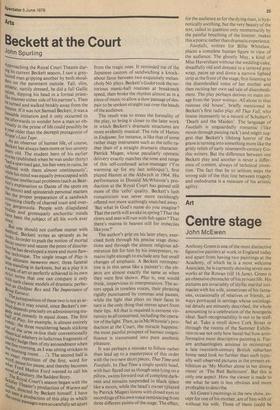Art
Centre stage
John McEwen
Anthony Green is one of the most distinctive figurative painters at work in England today and apart from having two paintings at the Academy, of which he is a most welcome Associate, he is currently showing seven new works at the Rowan (till 16 June). Green is an obsessive chronicler of his private life. His pictures are invariably of idyllic marital intimacies with his wife, sometimes of his fantasies, occasionally of relatives or friends, always portrayed in settings whose sociological details are minutely described, the whole amounting to a celebration of the bourgeois ideal. Such recognisability is not to be scoffed at. Take a stroll down Cork Street or through the rooms of the Summer Exhibition to see not only how banal but how uninformative most descriptive painting is. Future archaeologists anxious to reconstruct a late twentieth-century British suburban home need look no further than such typically well observed pictures in the present exhibition as 'My Mother alone in her dining room' or 'The Red Bathroom'. But this is only one aspect. How the viewer is made to see what he sees is less obvious and more profitable to describe.
All Green's paintings in the new show, except for one of his mother, are of him with or without his wife. Three of them could be called subjective or fantastic and four objective. All are painted in oils on hardboard often sawn into extravagant shapes to accommodate the distortions of the view or to emphasise the content, and most of them are large. Their shape has other functions too. It makes them distinctive objects as well as paintings, and close up it can make considerable areas of their surfaces work on the viewer's peripheral vision and thus tend to envelop him in what he is looking at. To increase this sensation of being drawn into the picture Green will also paint the subject from several angles. Traditionally painters have drawn up their pictures from the point of view of one eye, like a camera. They have squinted down their pencils with one eye closed, had a look and then squinted again till the whole canvas has been unified from a single standpoint. Green tries to realise in his paintings the way we register things in reality, with both eyes open and from many different angles as we move around and up and down. He also employs what he calls 'memory vision', that is, the way we remember things looking. In this Green is very much an expressionist, but his style of shifted planes is his own.
The seven paintings at the Rowan illustrate all these characteristics clearly enough, but three warrant explanation more than the others. 'The Peaceful Kingdom' is the most fully resolved work on view. All its sides are uneven but particularly so on the right and bottom. The viewer is encouraged by these broken edges to 'enter' the picture from the right, where the wall is visually flat to his cheek, from the bottom where the floor comes forward to meet him, or from above. The swirl of the room's effect is represented by the shadows on the ceiling. Your gaze is tilted from one plane to another. 'Our Tent' neatly incorporates three views into one so naturally that you hardly notice it. The hardboard is cut as a silhouette of the tent, one side only in other words, but the painting is of three sides of the interior as seen by a viewer looking in. 'The Artist' isolates the spotlights in a theatre. The darkness has been cut away to leave the beams forming an ironic crown with the artist, Anthony Green, on stage at its centre, viewed by an audience of Anthony Greens. One triangular beam eradiates the audience from the'stage, another the stage from the audience. The painting as a whole reflects the dilemma of the modern artist, free to paint anything and therefore prone to communicate nothing.
As a former star pupil at the Slade, Green is all too aware of the pitfalls confronting a painter in the late twentieth century, not least a figurative painter with a tradition stretching back 20,000 years. He was never phased by the traditional avant-gardist's cry that painting was dead, but he did unlearn most of what he was taught in order to reinstate the primary importance of the message and not the medium in his work. What the paintings show is the point, not how they are done. But it would be a foolhardy person who ever suggested that Anthony Green, because his paintings are easy to make contact with, is afaux naïf—or anything like it.



































 Previous page
Previous page